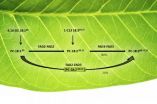(Press-News.org) (MEMPHIS, Tenn. – May 9, 2014) St. Jude Children's Research Hospital scientists studying two rare, inherited childhood neurodegenerative disorders have identified a new, possibly common source of DNA damage that may play a role in other neurodegenerative diseases, cancer and aging. The findings appear in the current issue of the scientific journal Nature Neuroscience.
Researchers showed for the first time that an enzyme required for normal DNA functioning causes DNA damage in the developing brain. DNA is the molecule found in nearly every cell that carries the instructions needed to assemble and sustain life.
The enzyme is topoisomerase 1 (Top1). Normally, Top1 works by temporarily attaching to and forming a short-lived molecule called a Top1 cleavage complex (Top1cc). Top1ccs cause reversible breaks in one strand of the double-stranded DNA molecule. That prompts DNA to partially unwind, allowing cells to access the DNA molecule in preparation for cell division or to begin production of the proteins that do the work of cells.
Different factors, including the free radicals that are a byproduct of oxygen metabolism, result in Top1ccs becoming trapped on DNA and accumulating in cells. This study, however, is the first to link the buildup to disease. The results also broaden scientific understanding of the mechanisms that maintain brain health.
Investigators made the connection between DNA damage and accumulation of Top1cc while studying DNA repair problems in the rare neurodegenerative disorders ataxia telangiectasia (A-T) and spinocerebellar ataxia with axonal neuropathy 1(SCAN1). The diseases both involve progressive difficulty with walking and other movement. This study showed that A-T and SCAN1 also share the buildup of Top1ccs as a common mechanism of DNA damage. A-T is associated with a range of other health problems, including an increased risk of leukemia, lymphoma and other cancers.
"We are now working to understand how this newly recognized source of DNA damage might contribute to tumor development or the age-related DNA damage in the brain that is associated with neurodegenerative disorders like Alzheimer's disease," said co-corresponding author Peter McKinnon, Ph.D., a member of the St. Jude Department of Genetics. The co-corresponding author is Sachin Katyal, Ph.D., of the University of Manitoba Department of Pharmacology and Therapeutics and formerly of St. Jude.
A-T and SCAN1 are caused by mutations in different enzymes involved in DNA repair. Mutations in the ATM protein lead to A-T. Alterations in the Tdp1 protein cause SCAN1.
Working in nerve cells growing in the laboratory and in the nervous system of specially bred mice, researchers showed for the first time that ATM and Tdp1 work cooperatively to repair breaks in DNA. Scientists also demonstrated how the proteins accomplish the task.
The results revealed a new role for ATM in repairing single-strand DNA breaks. Until this study, ATM was linked to double-strand DNA repair. ATM was also known to work exclusively as a protein kinase. Kinases are enzymes that use chemicals called phosphate groups to regulate other proteins.
Scientists reported that when Top1ccs are trapped ATM functions as a protein kinase and alert cells to the DNA damage. But researchers found ATM also serves a more direct role by marking the trapped Top1ccs for degradation by the protein complex cells use to get rid of damaged or unnecessary proteins. ATM accomplishes that task by promoting the addition of certain proteins called ubiquitin and SUMO to the Top1cc surface.
Tdp1 then completes the DNA-repair process by severing the chemical bonds that tether Top1 to DNA.
Mice lacking either Atm or Tdp1 survived with apparently normal neurological function. But compared to normal mice, the animals missing either protein had elevated levels of Top1cc. Those levels rose sharply during periods of rapid brain development and in response to radiation, oxidation and other factors known to cause breaks in DNA.
When researchers knocked out both Atm and Tdp1, Top1cc accumulation rose substantially as did a form of programmed cell death called apoptosis. Investigators reported that apoptosis was concentrated in the developing brain and few mice survived to birth. McKinnon said the results add to evidence that the brain is particularly sensitive to DNA damage.
Researchers then used the anti-cancer drug topotecan to link elevated levels of Top1cc to the cell death and other problems seen in mice lacking Atm and Tdp1. Topotecan works by trapping Top1ccs in tumor cells, resulting in the DNA damage that triggers apoptosis. Investigators showed that the impact of Top1cc accumulation was strikingly similar whether the cause was topotecan or the loss of Atm and Tdp1.
INFORMATION:
The study's other authors are Susanna Downing, Yang Li, Mikio Shimada, Jingfeng Zhao and Helen Russell, all of St. Jude; Youngsoo Lee, of the Ajou University School of Medicine, Suwon, Korea, and formerly of St. Jude; Karin Nitiss and John Nitiss, both of the University of Illinois-Chicago and formerly of St. Jude; and John Petrini of the Memorial Sloan-Kettering Cancer Center in New York.
The research was funded in part by grants (NS37956, CA96832, CA21765, GM59413) from the National Institutes of Health (NIH); grants (CA52814, CA82313) from the National Cancer Institute, part of the NIH; the Geoffrey Beene Foundation, the Goodwin Foundation, the University of Manitoba, CancerCare Manitoba, the Manitoba Health Research Council Establishment Award and ALSAC.
St. Jude Media Relations Contacts
Carrie Strehlau
desk (901) 595-2295
cell (901) 297-9875
carrie.strehlau@stjude.org
Summer Freeman
desk (901) 595-3061
cell (901) 297-9861
summer.freeman@stjude.org
Discovery links rare, childhood neurodegenerative diseases to common problem in DNA repair
The study of 2 rare childhood neurodegenerative diseases leads St. Jude Children's Research Hospital scientists to a new source of DNA damage that may play a role in a wide range of health problems, including cancer
2014-05-09
ELSE PRESS RELEASES FROM THIS DATE:
Longevity gene may boost brain power
2014-05-09
Scientists showed that people who have a variant of a longevity gene, called KLOTHO, have improved brain skills such as thinking, learning and memory regardless of their age, sex, or whether they have a genetic risk factor for Alzheimer's disease. Increasing KLOTHO gene levels in mice made them smarter, possibly by increasing the strength of connections between nerve cells in the brain. The study was partly funded by the National Institutes of Health.
"This could be a major step toward helping millions around the world who are suffering from Alzheimer's disease and ...
Autism-related protein shown to play vital role in addiction
2014-05-09
BELMONT - In a paper published in the latest issue of the neuroscience journal Neuron, McLean Hospital investigators report that a gene essential for normal brain development, and previously linked to Autism Spectrum Disorders, also plays a critical role in addiction-related behaviors.
"In our lab, we investigate the brain mechanisms behind drug addiction – a common and devastating disease with limited treatment options," explained Christopher Cowan, PhD, director of the Integrated Neurobiology Laboratory at McLean and an associate professor of Psychiatry at Harvard Medical ...
Quick test can help spot depressed teenagers, UT Arlington nursing researcher finds
2014-05-09
A few minutes spent filling out a widely accepted mental health assessment in a health care provider's waiting room could make a big difference for some teenagers suffering from depression, according to new study from a nursing researcher at The University of Texas at Arlington.
Sharolyn Dihigo, a nurse practitioner and clinical assistant professor in the UT Arlington College of Nursing, recently examined available research to determine whether nurse practitioners and others in primary care settings should add a mental health screening to well visits for teenage patients. ...
Conducting polymer films decorated with biomolecules for cell research use
2014-05-09
The ability to create conducting polymer films in a variety of shapes, thicknesses and surface properties rapidly and inexpensively will make growing and testing cells easier and more flexible, according to a team of Penn State bioengineers.
"The ultimate goal of this collaborative project is to be able to create a substrate for growth and manipulation of cells," said Sheereen Majd, assistant professor of bioengineering. "Cells on a surface need to recognize biomolecules like extracellular matrix proteins to be able to adhere and grow. We ultimately would like to be able ...
Grape consumption may offer benefits for symptomatic knee osteoarthritis
2014-05-09
Fresno, CA – New research presented last week at the Experimental Biology conference in San Diego, California, suggests that regular grape consumption may help alleviate pain associated with symptomatic osteoarthritis of the knee, and improve joint flexibility and overall mobility. Researchers attribute these potential benefits to the polyphenols found in grapes.
The sixteen week clinical study, undertaken by Texas Woman's University, was designed to investigate the benefits of grape consumption on inflammation and osteoarthritis outcomes. 72 men and women with knee ...
Calcium supplements not associated with increased risk of cardiovascular disease in women
2014-05-09
Boston, MA – Calcium supplements are widely taken by women for bone health. Previous studies have suggested that calcium supplements may increase risk of cardiovascular disease, but the data has been inconsistent. A new study by researchers at Brigham and Women's Hospital (BWH) did not find that calcium supplement intake increases risk of cardiovascular disease in women.
The study is published online this month in Osteoporosis International.
Researchers examined supplemental calcium use and incident cardiovascular disease in a prospective cohort study of 74,245 women ...
Study validates air sampling techniques to fight bioterrorism
2014-05-09
ST. LOUIS – Air and surface sampling techniques currently used by the US government are effective in fighting bioterrorism and potentially saving lives, a Saint Louis University researcher finds.
Results published in Biosecurity and Bioterrorism by Alexander Garza, M.D., MPH, former chief medical officer at the Department of Homeland Security and a team of researchers from Los Alamos National Lab reviewed the data from a series of experiments simulating a bioterrorism attack against the Pentagon. Garza is now the associate dean for public health practice and associate ...
New species of metal-eating plant discovered in the Philippines
2014-05-09
Scientists from the University of the Philippines, Los Baños have discovered a new plant species with an unusual lifestyle — it eats nickel for a living — accumulating up to 18,000 ppm of the metal in its leaves without itself being poisoned, says Professor Edwino Fernando, lead author of the report. Such an amount is a hundred to a thousand times higher than in most other plants. The study was published in the open access journal PhytoKeys.
The new species is called Rinorea niccolifera, reflecting its ability to absorb nickel in very high amounts. Nickel hyperaccumulation ...
Plants' oil-desaturating enzymes pair up to channel metabolites
2014-05-09
UPTON, NY-Plant scientists at the U.S. Department of Energy's Brookhaven National Laboratory have found that certain enzymes responsible for desaturating fatty acids, the building blocks of oils, can link up to efficiently pass intermediate products from one enzyme to another. "Engineering these enzyme interactions to channel metabolites along desired metabolic pathways could be a new approach for tailoring plants to produce useful products," said Brookhaven biochemist John Shanklin, lead author on a paper reporting the results in the Journal of Biological Chemistry.
Getting ...
Leadless pacemaker showing promising results after 1 year
2014-05-09
Vivek Reddy, MD, Director of Arrhythmia Services for The Mount Sinai Hospital, reported his promising12-month follow-up data showing the world's first leadless pacemaker is demonstrating overall device performance comparable to conventional pacemakers. Dr. Reddy presented the one-year LEADLESS study data findings during his late-breaking clinical trial presentation on May 9 at Heart Rhythm 2014, the Heart Rhythm Society's 35th Annual Scientific Sessions in San Francisco, CA.
The LEADLESS study's long-term follow-up has evaluated 32 patients with a slowed heartbeat, bradycardia, ...
LAST 30 PRESS RELEASES:
The perfect plastic? Plant-based, fully saltwater degradable, zero microplastics
Bias in data may be blocking AI’s potential to combat antibiotic resistance
Article-level metrics would provide more recognition to most researchers than journal-level metrics
Satiety’s little helper: Protein that supports appetite regulating protein identified
UF dives deep into predicting storm damage with computer models
A stormy ocean voyage yields insights on the global carbon cycle
Scientists identify first non-coding gene that controls cell size
Demonstration of altermagnetism in RuO₂ thin films -- A new magnetic material for the AI era
Penn researchers awarded $25M to conduct trial using smartphones to fight heart disease
PCORI awards funding for new patient-centered healthcare research
Exploring the origins of the universe: 145 low-noise amplifiers complete ALMA telescopes
Empress cicada wings help illuminate molecular structure
Using sound waves to detect helium
Time burden in patients with metastatic breast and ovarian cancer from clinic and home demands
Researchers discover bias in AI models that analyze pathology samples
Scientists ID potential way to prevent brain injuries from triggering Alzheimer's
MASTER 2nd Open Call: Execution period kick-off
Algae for health in food and pharma
Advanced microrobots driven by acoustic and magnetic fields for biomedical applications
Chicago health information leader recognized for raising CPR readiness and blood pressure awareness
The Intimate Animal, a new book from Kinsey Institute Executive Director Dr. Justin Garcia
When blue-collar workers lose union protection, they try self-employment
New video dataset to advance AI for health care
MEA-based graph deviation network for early autism syndrome signatures in human forebrain organoids
New modeling approach sheds light on rare gut disease
Study documents potentially hazardous flame retardants in firefighter gear
Can certain bacteria regulate aging of the immune system and its related alterations?
AI model helps diagnose often undetected heart disease from simple EKG
There are fewer online trolls than people think
Cell membrane fluctuations produce electricity
[Press-News.org] Discovery links rare, childhood neurodegenerative diseases to common problem in DNA repairThe study of 2 rare childhood neurodegenerative diseases leads St. Jude Children's Research Hospital scientists to a new source of DNA damage that may play a role in a wide range of health problems, including cancer





